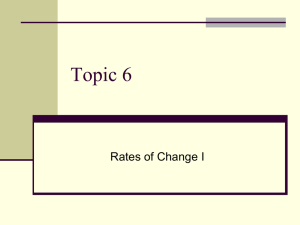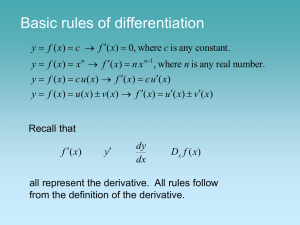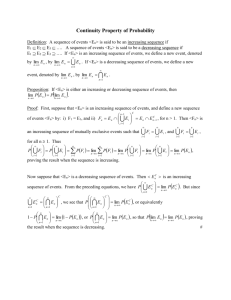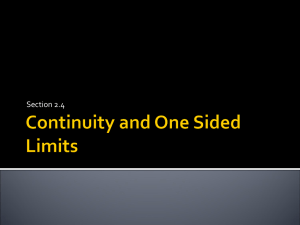Answer to HW 1
advertisement
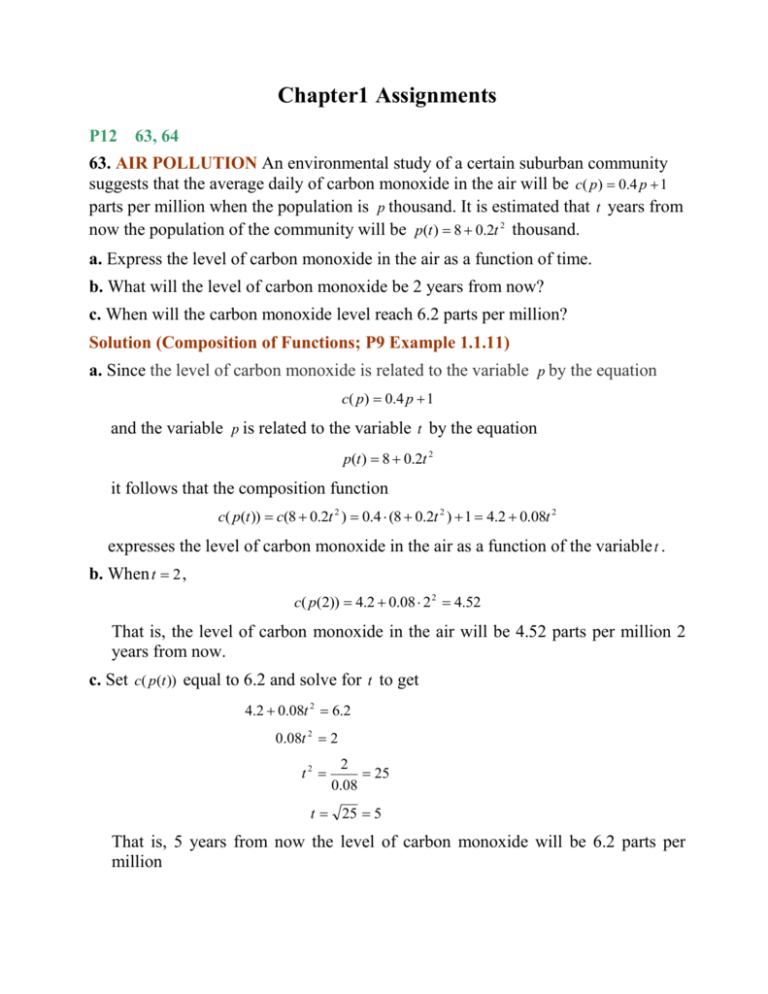
Chapter1 Assignments P12 63, 64 63. AIR POLLUTION An environmental study of a certain suburban community suggests that the average daily of carbon monoxide in the air will be c( p) 0.4 p 1 parts per million when the population is p thousand. It is estimated that t years from now the population of the community will be p(t ) 8 0.2t 2 thousand. a. Express the level of carbon monoxide in the air as a function of time. b. What will the level of carbon monoxide be 2 years from now? c. When will the carbon monoxide level reach 6.2 parts per million? Solution (Composition of Functions; P9 Example 1.1.11) a. Since the level of carbon monoxide is related to the variable p by the equation c( p) 0.4 p 1 and the variable p is related to the variable t by the equation p(t ) 8 0.2t 2 it follows that the composition function c( p(t )) c(8 0.2t 2 ) 0.4 (8 0.2t 2 ) 1 4.2 0.08t 2 expresses the level of carbon monoxide in the air as a function of the variable t . b. When t 2 , c( p(2)) 4.2 0.08 2 2 4.52 That is, the level of carbon monoxide in the air will be 4.52 parts per million 2 years from now. c. Set c( p(t )) equal to 6.2 and solve for t to get 4.2 0.08t 2 6.2 0.08t 2 2 t2 2 25 0.08 t 25 5 That is, 5 years from now the level of carbon monoxide will be 6.2 parts per million 64. MANUFACTURING COST At a certain factory, the total cost of manufacturing q units during the daily production run is C (q) q 2 q 900 dollars. On a typical workday, q(t ) 25t units are manufactured during the first t hours of a production run. a. Express the total manufacturing cost as a function of t . b. How much will have been spent on production by the end of the third hour? c. When will the total manufacturing cost reach $11,000? Solution (Composition of Functions; P9 Example 1.1.11) a. Since (the level of carbon monoxide is related to the variable p by the equation) C (q) q 2 q 900 and (the variable p is related to the variable t by the equation) q (t ) 25t it follows that the composition function C (q(t )) (25t ) 2 25t 900 625t 2 25t 900 expresses total manufacturing cost as a function of t . b. When t 3 , C (q(3)) 625 32 25 3 900 6600 That is, $6600 will have been spent on production by the end of third hour. c. Set C (q(t )) equal to 11,000 and solve for t to get 625t 2 25t 900 11000 t 1 1 25 * 4 * 404 1 201 50 50 Since t 0 , we get t 4 .That is , the total manufacturing cost reach $11,000 by the end of the forth hour. P37 19 , 27 , 33 In Problems 19, 27 and 34, write an equation for the line with the given properties 19.Through (2, 0) with slope 1. Solution (Linear Function; P32 Example 1.3.4) Use the formula y y0 m( x x0 ) with ( x0 , y0 ) (2,0) and m 1 to get y 0 1 ( x 2) Rewrite it as y x2 1 5 2 1 3 4 27. Through ( ,1) and ( , ) . Solution (Linear Function; P32 Example 1.3.2) First comput the slope 1 1 45 m 4 2 1 52 ( ) 3 5 1 5 45 1 45 43 y 1 ( x ) or y x 52 5 52 52 33. Through (3,5) and perpendicular to the line x y 4 Then use the point-slope formula with ( ,1) as given point ( x0 , y0 ) to get Solution (Linear Function; P35 Example 1.3.5(b)) By rewriting the equation x y 4 in the slope-intercept form y x 4 , we see that this line has the slope ml 1 . A line perpendicular to line x y 4 must have slope m P56 1 1 . Since the required line contains point (3,5), we have ml y 5 x3 y x2 45 , 48 45. SUPPLY AND DEMAND Producers will supply x units of a certain commodity to the market when the price is p S (x) dollars per unit, and consumers will demand (buy) x units when the price is p D(x) dollars per unit, where S ( x) 2 x 15 and D( x) 385 x 1 a. Find the equilibrium production level xe and the equilibrium price p e . b. Draw the supply and demand curves on the same graph. c. Where does the supply curve cross the y axis? Describe the economic significance of this point. Solution ( P49 Example 1.4.6) a. Maket equilibrium occurs when S ( x) D( x) 385 x 1 2 2 x 17 x 15 385 2 x 2 17 x 370 0 ( x 10)( 2 x 37) 0 2 x 15 x 10 or x 18.5 Since only positive values of the production level x are meaningful, we reject x 18.5 and conclude that equilibrium occurs when xe 10 . The corresponding equilibrium price can be substiduting x 10 into either the supply function or the demand function. Thus, pe S (10) 2(10) 15 35 b. Equilibrium point (10, 35) c. when the supply curve crosses the y axis, S (0) 15 thus the supply curve crosses the y axis at (0,15) . This point mean that no units will be produced until the price is at least $15. 48. BREAK-EVEN ANALYSIS A furniture manufacturer can selll dining room tables for $70 apiece. The manufacturer’s total cost consists of a fixed overhead of $8,000 plus production costs of 30 per table. a. How many tables must the manufacturer sell to break even? b. How many tables must the manufacturer sell to make a profit of $6,000? c. What will be the manufacturer’s profit or loss if 150 tables are sold? d. On the same set of axes, graph the manufacturer’s total revenue and total cost fuctions. Explain how the overhead can be read from the graph. Solution (P51 Example 1.4.7) If x is the number of units the manufactured and sold, the total revenue is given by R( x) 70 x and the total cost by C ( x) 8000 30 x . a. To find the break-even point, set R ( x ) equal to C ( x) and solve 70x 8000 30 x 40x 8000 so that x 200 It follows that the manufacturer will have to sell 200 units to break even. b. The profit P ( x ) is revenue minus cost. Hence P( x) R( x) C ( x) 70 x (8000 30 x) 40 x 8000 To determine the number of units that must be sold to make a profit of $6,000, set the formula for profit P ( x ) equal to 6,000 and solve 40x 8000 6000 x 350 so that It follows that the manufacturer will have to sell 350 units to make a profit of $6,000. c. The profit from the sale of 150 tables is P(150) 40(150) 8000 2000 The minus sign indicates a loss, and it follows that the manufacturer will loss $2,000 if 150 tables are sold. d. R(x) y Break-even point 8000 0 C(x) (200, 14000) x From the graph, we can find that the overhead is the y intercept of C ( x) . P69 11 In Problem 11, find the indicated limit if it exists. 2 11. lim ( x 1) ( x 1) x3 Solution (P63 Example 1.5.2) Apply the properties of limits to obtain lim( x 1) 2 ( x 1) (lim( x 1)) 2 lim( x 1) (3 1) 2(3 1) 16 x 3 x 3 x 3 P70 15 , 19 , 23 , 25 , 27 , 31 , 35 In Problems 15, 19, 23 and 25 , find the indicated limit if it exists 15. lim x 5 x3 5 x Solution (P64 Example 1.5.4) The quotient rule for limits does not apply in this case since the limit of the denominator is lim(5 x) 0 x 5 x 3) 8 , which is not equal to zero, you can Since the limit of the numerator is lim( x 5 conclude that the limit of the quotient does not exist. 19. lim x 5 x 2 3x 10 x5 0 0 Solution ( ; P64 Example 1.5.5) Both the numerator and the denominator approach 0 as x approach 5. Simplify the quotient to obtain: x 2 3x 10 ( x 5)( x 2) x2 x 5 x 5 and then take the limit to get 23. x 2 3x 10 lim lim( x 2) 7 x 5 x 5 x 5 x2 x 6 lim 2 x 2 x 3 x 2 0 0 Solution ( ; P64 Example 1.5.5) Both the numerator and the denominator approach 0 as x approach -2. Simplify the quotient to obtain: x 2 x 6 ( x 2)( x 3) x 3 x 2 3x 2 ( x 2)( x 1) x 1 and then take the limit to get ( x 3) x2 x 6 x 3 xlim 2 lim 5 x 2 x 2 3 x 2 x 2 x 1 lim ( x 1) lim x 2 25. lim x4 x 2 x4 0 0 Solution ( ; P64 Example 1.5.6) Both the numerator and the denominator approach 0 as x approach 5. to simplify the quotient, we rationalize the numerator: x 2 ( x 2)( x 2) x4 x4 ( x 4)( x 2) ( x 4)( x 2) and then take the limit to get 1 x 2 lim x 4 x 2 1 1 lim x 4 x4 x 2 4 f ( x) and lim f ( x) . If the limiting value is For problems 27, 31 and 35, find xlim x infinite, indicate whether it is or . 27. f ( x) x 3 4 x 2 4 Solution Since the values of this function increase without bound as x increases, we get lim ( x3 4 x2 4) x Similarly, we can obtain lim ( x3 4 x2 4) x 31. f ( x) x 2 2x 3 2 x 2 5x 1 Solution ( ; P67 Example 1.5.8) The highest power in the denominator is x 2 . Divide the numerator and the denominator by x 2 to get x2 2x 3 1 2 / x 3/ x 2 1 0 0 1 lim x 2 x 2 5 x 1 x 2 5 / x 1/ x 2 200 2 x2 2x 3 1 2 / x 3/ x 2 1 0 0 1 lim lim x 2 x 2 5 x 1 x 2 5 / x 1/ x 2 200 2 3x 2 6 x 2 f ( x) 2x 9 lim 35. Solution ( ; P68 Example 1.5.10) The highest power in the denominator is x . Divide the numerator and the denominator by x to get 3x 2 6 x 2 3x 6 2 / x lim x x 2x 9 29/ x lim since 2 lim (3 x 6 ) and x x 9 lim (2 ) 2 x x it follows that 3x 2 6 x 2 x 2x 9 lim Similarly, we can get 3x 2 6 x 2 3x 6 2 / x lim x x 2x 9 29/ x lim P71 51 51. PER CAPITA EARNINGS Studies indicate that t years form now, the population of a certiain country will be p 0.2t 1,500 thousand people, and that gross earnings of the country will be E million dollars, where E (t ) 9t 2 0.5t 179 a. Express the per capita earnings of the country P E / p as a function of time t . (take care with the units.) b. What happens to the per capita earnings in the long run (as t ) Solution (P68 Example 1.5.9) a. Both the gross earnings of the country E and the population p are functions of time t . Hence the per capita earnings of the country is P(t ) E (t ) / p(t ) 9t 2 0.5t 179 0.2t 1500 thousand dollars per person . b. Since lim P(t ) lim t t 9t 2 0.5t 179 9 0.5 / t 179 / t 2 lim 15 , t 0.2t 1500 0.2 1500 / t the per capita earnings will be 15 thousand dollar per person ( $1,500 per person) in the long run (as t ). P81 11 , 13 In Problems 11 and 13, find the indicated one-sided limit. If the limiting value is infinite, indicate whether it is or . 11. lim x 3 x 1 2 x3 Solution lim x 3 x 1 2 ( x 1 2)( x 1 2) lim lim x 3 x3 x3 ( x 3)( x 1 2) 2 x 2 x lim f ( x ) lim f ( x ) 13. and , where f ( x) x 3 x 3 3 x Solution (P74 Example 1.6.1) Since f ( x ) 2 x 2 x for x 3 , we have lim f ( x ) lim (2 x 2 x ) 15 x 3 x 3 1 x 1 2 if x 3 if x 3 1 4 Similarly, f ( x ) 3 x for x 3 , so lim f ( x ) lim ( 3 x ) 0 x 3 x3 P82 19 , 23 , 26 , 33 , 39 In problems 19, 23 and 26, decide if the given function is continuous at the specified value of x. 19. f ( x) x 1 x 1 at x 1 . Solution (Verify the three criteria for continuity in P77) Since f (1) is undifined, the function f ( x) x 1 2 23. f ( x) x 1 is not continuous at x 1. x 1 if x 2 at x 2 if x 2 Solution (P78 Example 1.6.6) Since the function f ( x ) approaches 3 as x approaches 2 from the left side and f ( x ) does not exist. Thus, approuches 2 as x approacher 2 from the right side, lim x 2 this function is not continuous at x 2 x2 1 26. f ( x) x 1 x 2 - 3 if x 1 at x 1 if x 1 Solution (P78 Example 1.6.6) f (1) is defined and f ( 1) 2 . Since x2 1 lim ( x 1) 2 x 1 x 1 x 1 x 1 and lim f ( x ) lim ( x 2 3) 2 lim f ( x ) lim x 1 x 1 lim f ( x ) exists and lim f ( x ) 2 f ( 1) . x 1 x 1 Thus the funcion is continuous at x 1 In Problems 33 and 39, list all the value of x for which the given function is not continuous. 33. f ( x) 3x 2 ( x 3)( x 6) Solution (P78 Example 1.6.6) This functin is a rational function, it follows that f ( x ) will be continuous everywhere except x 3 and x 6 . 3x 2 if x 0 x x if x 0 39. f ( x) 2 Solution (P78 Example 1.6.6) Since 3 x 2 and x 2 x are both polynomials, it follows that f ( x ) will be f ( x ) does not exist, continuous everywhere except possibly at x 0 . We find that lim x 0 since f ( x ) approaches -2 from the left and 0 from the right. It follows that f ( x ) is coninuous at every real number except 0. P83 44 44. WATER POLLUTION A ruptured pipe in a North Sea oil rig produces a circular oil slick that is y meters thick at a distance x meters from the rupture. Turbulence makes it diffucult to directly measure the thickness of the slick at the source (where x 0 ), but for x 0 , it is found that y 0.5( x 2 3x) x3 x 2 4x Assuming the oil slick is continuously distributed, how thick would you expect it to be at the source? Solution Clealy the function y 0.5( x 2 3x) is not defined at x 0 . Since the oil thick is x3 x 2 4x continuously distributed, we can expect the oil thich will be 0.5( x 2 3 x ) 0.5( x 3) lim f ( x ) lim 3 lim 2 0.425 x 0 x 0 x x 2 4 x x 0 x x 4 meters at the source. P84 51 , 55 In Problem 51, find the values of the constant A such that the function f(x) will be continuous for all x. Ax 3 51. f ( x) 3 x 2 x if x 2 2 if x 2 Solution (P79 Example 1.6.7) Since Ax 3 and 3 x 2 x 2 are both polynomials, it follows that f ( x ) will be continuous everywhere excpet possibly at x 2 . Moreover, f ( x ) approaches 2 A 3 as x approaches 2 from the left side and approuches 9 as x approacher 2 from f ( x ) exists, we must have 2 A 3 9 or A 6 , in which the right side. Thus, for lim x 2 case lim f ( x ) 9 f ( 2) x2 This means that f ( x ) is continouous for all x when A 6 . 55. Show that the equation interval 0 x 8 3 x 8 9 x 2 / 3 29 has at least one solution for the Solution (P80 Example 1.6.9) Let f ( x ) 3 x 8 9 x 2 / 3 29 . Then f (0) 31 and f (8) 7 .Since lim f ( x) f (c) x c c (0,8) lim f ( x) f (0) x 0 and lim f ( x) f (8) x 8 f ( x ) is continuous for 0 x 8 . And 31 0 7 ,the function can attain 0. So the equation 3 x 8 9 x 2 / 3 29 has at least one solution for the interval 0 x 8 . OR Let f ( x) 3 x 8 9 x 2 / 3 . Then f (0) 2 and f (8) 36 . Since lim f ( x) f (c) x c c (0,8) lim f ( x) f (0) x 0 and lim f ( x) f (8) x 8 f ( x ) is continuous for 0 x 8 . And 2 29 36 , the function can attain 29. So the equation 3 x 8 9 x 2 / 3 29 has at least one solution for the interval 0 x 8 .



